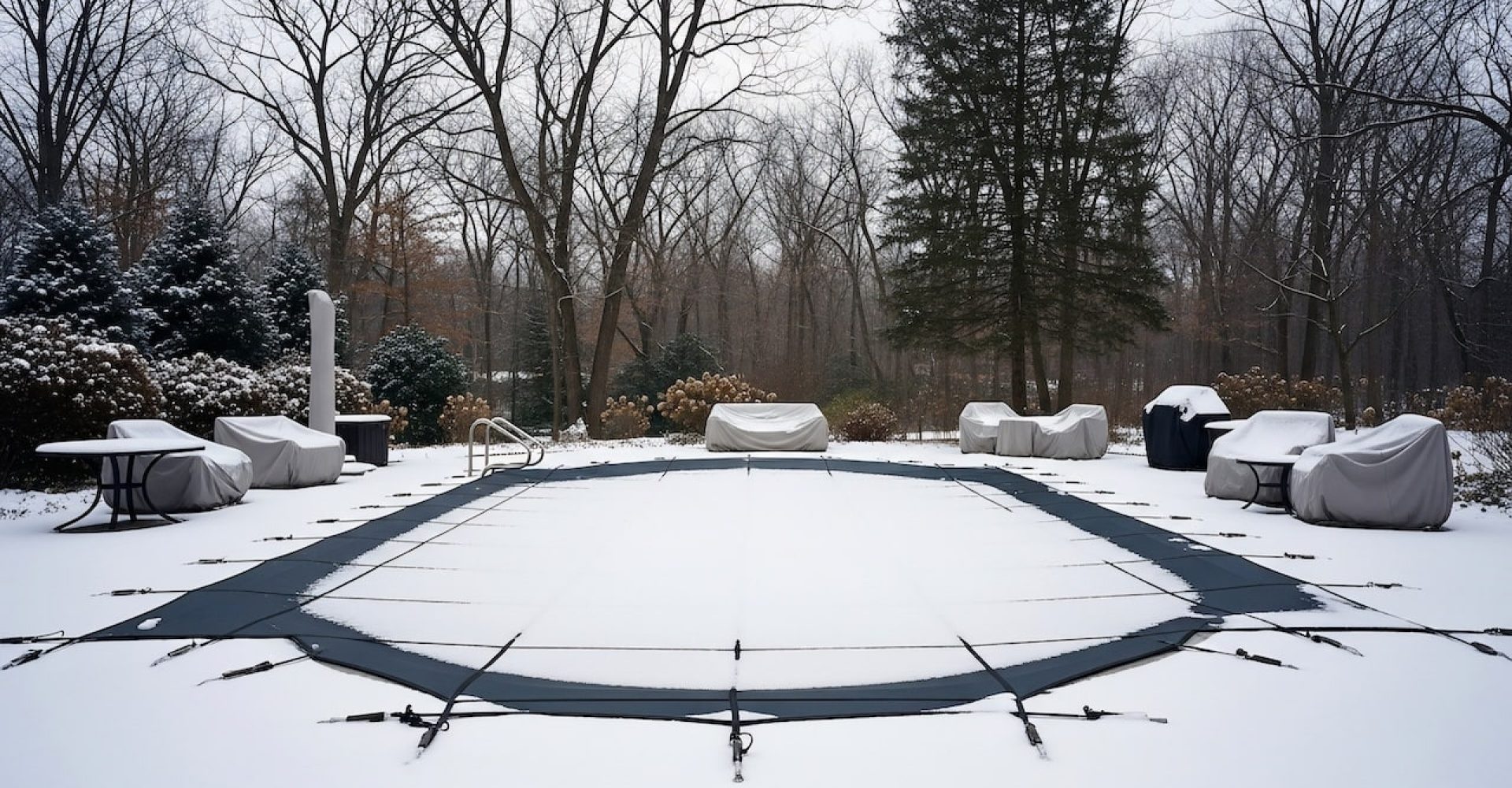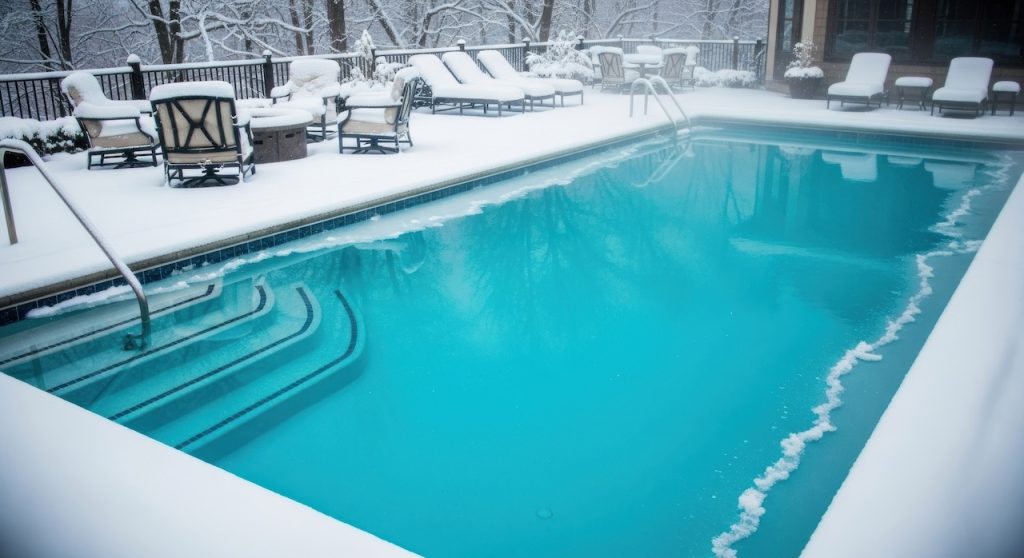
A great swimming pool is a perfect place to spend time in the warmer months. Whether you like to read in a poolside cabana between dips or you have kids making the most of every aquatic moment they can grab, a pool makes for an incredible summer.
The opposite side of that coin is ensuring you take necessary steps for pool freeze protection over the course of the winter months. It can be easy to assume that pool maintenance ends with the swimming season, but protecting your investment in your pool is a year-round project.
The main reason that you need to winterize a pool is the fact that water expands as it freezes. That doesn’t seem like it should cause that much trouble, but it very much does. In addition to potentially bursting pipes, freezing water can damage or knock free your tiles while making significant cracks in your concrete.
Repairing the damage from a pool freeze can cost thousands of dollars. Patching up concrete and replacing important parts of your filtration and circulation systems do not come cheap — and they require a level of knowledge that makes a DIY approach essentially impossible.
It’s always a good idea to check on your winter preparedness with experts, but before you do that, let’s go over some tips to help you understand what to look out for and plan out your freeze protection for pool equipment.
Before diving into some of the finer points of freeze protection, let’s look at some of the specific areas of your swimming pool that can be negatively affected by the cold.
Freezing temperatures can result in damage, including cracked fittings, burst pipes, broken pumps, popped pool tiles, inoperable skimmers and valves, and busted filters. And that’s just the damage you risk from the cold!
Winter storms can also mess up your pool. Heavy snow can bow your winter pool cover and mess up your careful winter plans. By taking proper steps to prepare and staying vigilant throughout the winter, you can protect every part of your pool.

As the saying goes, an ounce of preparation is worth a pound of cure. This is true when it comes time to winterize a pool. By taking steps before the weather turns, you can set yourself up for a smooth pool opening come the spring.
The first steps in pool freeze protection are to remove accessories and drain the water to below the tile line. You do not want to completely empty your pool. Having enough water in your pool over the winter is actually key to pool plumbing freeze protection.
Moving water doesn’t freeze. That’s why you need to keep water in your pool. You need enough to run through your filtration system throughout the winter. It’s the same principle as letting your faucet drip a bit during extremely cold weather to help protect your pipes from bursting.
You should also balance your water as part of your winterization process. If you want, you can shock it first. But make sure that, once you are ready to officially close up for the season, your water has a good, near-neutral pH balance.
Check and clean out your baskets, skimmers and/or filters. The less stuff that’s there at the start of winter, the less you have to deal with in the spring after a couple months of constant running water. It’s a good idea to cover any exposed machinery with a tarp to protect it from snowfall as well.
A major part of protecting your pool from extreme weather and below freezing temperatures is setting up your plumbing for the winter. Again, the biggest threat to your pool is freezing water expanding — if that happens in your pipes, they will burst.
While you want to keep water in your pool and flowing through your filters, you’ll want to remove your plugs and drain the plumbing. You will also want to use an air compressor to blow out your lines to ensure that they are clear.
You should take note of the highest risk pipes and give them some extra attention. This can mean wrapping them in towels or other insulating materials, treating them with some non-toxic antifreeze, or a combination of both.
Be wary of setting up gas or electric heaters out by your pipes and equipment. They can short out, melt any tarps you’re using to block precipitation, or cause fires. Stick to chemical freeze protection or physical insulation strategies.
Cracks in the pool itself are not the only thing that you need to watch out for. If water gets into cracks in the concrete of your pool deck and expands, it can open the door for more water to make its way to the pool itself and cause you all kinds of trouble.
Applying weather sealant to your pool deck is an absolute must. It will protect against typical winter weather like snow as well as providing protection from hail and wind pool damage. Weather sealant is pretty easy to apply, you just need to be sure that you get good coverage across the length and breadth of your deck.

When not in use during the summer months, many pool owners will roll out a cover to keep as much debris out of the water as possible. In the winter, you need a pool cover that will stand up to the harsh elements.
You’ll need to choose between a mesh and solid cover. Both play important roles in debris management after storms and throughout a long offseason. The primary difference is that mesh covers allow precipitation to drip through while solid covers block everything.
No matter which cover you choose, you should be sure to clear the top of it somewhat regularly. A buildup of dead leaves or dirty snow on a mesh cover can lead to dirty water entering your pool’s ecosystem. Too much weight on a solid cover can result in bending or breaking, rendering the cover essentially useless because it no longer fits snugly over your pool.
In the upper midwest, major storms and long strings of days at sub-zero temperatures are not rare occurrences. So while much of your pool freeze protection planning should revolve around setting yourself up for the full winter season, you should also take steps to prepare for large weather events.
Pool safety around severe weather hinges on mitigating potential damage. Be prepared for power outages. For example, even if your power goes out, you should still shut down all of your breakers. You should also be prepared to adjust your valves, plugs, and equipment to recommended settings for a lack of power.
When it is safe to do so, clear off your pool cover and check that your winterization precautions are still working as intended. This is in addition to the recommended monthly checks on your pool that you should do throughout the winter.
Owning a swimming pool can be a great project for people with a healthy do-it-yourself mentality. But when it comes to winterization, unless you have plenty of experience and all the necessary equipment like an air compressor, it is wise to work with experienced professionals.
It is difficult to sum up a thorough pool storm prep checklist that covers every nuance of every swimming pool. And that doesn’t even factor in things like saltwater pools or pools that use UV filtration systems or automated controls for water circulation.
Tracer has helpful information on their website about closing down your pool for the offseason, of course. But communication with someone who knows swimming pools inside and out is invaluable.
Have questions about UV pool sanitizer maintenance in winter? Need help getting the right pool cover? Want recommendations on weather sealant and antifreeze? The team at Tracer can work with you.
There is a lot of winterization that you can do on your own, but it is so much better to be safe than sorry when it comes to protecting the investment you have made in your swimming pool.
So it is a very good idea to reach out before the weather gets too cold.
Let your early preparation protect you from huge repair costs and delayed use of your pool when winter ends. At that point, you can focus on simpler things like how to prevent algae after a heavy rain.
Depending on the geography of your home and yard, the shape of your pool, the lining, the accessories and equipment you use with your pool, and other concerns — such as the specific demands of saltwater pool care in winter — you will have very specific and unique needs that you have to resolve as part of your offseason prep.
The experienced team at Tracer can help answer your questions and even help you get your pool ready for the winter. You may not have all the tools and know-how for pool winterization, but you can bet that we do.
Pool freeze protection is so important, especially in areas where the weather drops below zero frequently. By taking appropriate steps in the fall, you ensure that re-opening your pool in the spring will be a much simpler process.
So take the steps we have looked at today and contact Tracer to get the help you need to cover those things that you don’t have the equipment to handle on your own. Your pool is a valuable investment. Don’t just leave it out in the cold.

A: Full winterization, line blowing, equipment draining, cover installation, chemistry targets, and a written condition report.
A: It can add a margin of safety in vulnerable or hard-to-drain lines. Follow manufacturer guidance.
A: It helps by circulating water during cold snaps. It is not a substitute for full winterization.
A: Yes, within manufacturer guidance for your pool type and cover system.
A: Cover tension, plugs, leaks, pump priming, pressure, and water balance. Call a pro if anything looks off.